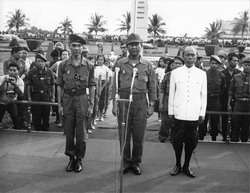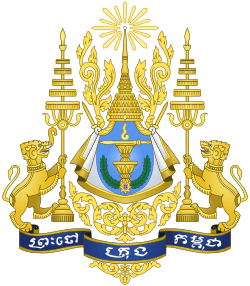In Tam
| In Tam | |
|---|---|
| 27th Prime Minister of Cambodia | |
|
In office May 6, 1973 – December 9, 1973 | |
| President | Lon Nol |
| Preceded by | Hang Thun Hak |
| Succeeded by | Long Boret |
| President of the National Assembly | |
|
In office March 18, 1970 – March 11, 1971 | |
| Prime Minister | Lon Nol |
| Minister for the Interior | |
|
In office 1964–1966 | |
| Prime Minister | Norodom Kantol |
| Personal details | |
| Born |
September 22, 1922 Kampong Cham, Cambodia |
| Died |
April 1, 2006 (aged 83) Chandler, Arizona, U.S. |
| Political party | Democratic Party |
In Tam (Khmer: អ៊ិន តាំ; September 22, 1922 – April 1, 2006) was a former Prime Minister of Cambodia. He served in that position from May 6, 1973 to December 9, 1973, and had a long career in Cambodian politics.
Political career
In Tam was born in Prek Kak village in Stung Treng district, Kampong Cham Province, in eastern Cambodia. As a child he studied Pali at Stung Treng Pagoda, before going on to study at the Lycee Sisowath. After serving as an inspector of the provincial militia, he eventually reached the rank of Brevet-General and rose to the position of governor of Takeo Province.
During the 1960s Tam served in several posts in the Sangkum government of Prince Norodom Sihanouk, most notably as interior minister from 1964 to 1966.
He was involved in the arrest of his own nephew Preap In, who was accused of membership of an anti-Sihanouk, rightist guerrilla organisation, the Khmer Serei; Preap In was later executed. Despite his former loyalty to Sihanouk, however, In Tam was one of the main figures behind the Cambodian coup of 1970, with the vote to remove Sihanouk from power taking place under his direction. As President of the National Assembly, In Tam personally proclaimed the Khmer Republic in October 1970.[1]

After 1970, Tam came into increasing conflict with the coup's leader, Lon Nol. The latter took action in October 1971 to strip the National Assembly of its legislative powers, citing a growing state of emergency in the Cambodian Civil War: this provoked a protest by Tam and 400 monks.[2]
In 1972, Tam ran in presidential elections against Lon Nol and Keo An. A United States National Security Council report judged Tam to be the among the most experienced and politically mature of Cambodian politicians at the time, with a deserved reputation for incorruptibility and a modest lifestyle.[3] He came in second place behind Lon Nol, receiving 24% of the vote: it was widely believed that if the elections had been fairly conducted In Tam would in fact have won outright, and despite manipulation of the vote still managed to win in the capital, Phnom Penh.[4] Along with Prince Sisowath Sirik Matak's Republican Party, Tam's Democratic Party refused to contest the parliamentary elections later that year in protest at rules that they saw as favouring the Socio-Republican Party of Lon Nol and his brother Lon Non.
The following year, In Tam served as prime minister for seven months in Lon Nol's government, and was later put in charge of a programme designed to encourage communist cadres to defect to the government side, only to later ‘retire’ from politics and live with his family and supporters in Battambang. He was succeeded as Prime Minister by Long Boret.
When the Khmer Rouge gained control of Cambodia in April 1975, In Tam was at his farm in Poipet. He almost certainly would have been executed, but he fled to Thailand and attempted to organise a rebellion against the Khmer Rouge in the border areas. This did not last long, however, as the Thai authorities deported him. He went to France and then in 1976 moved to the United States where he received asylum.
In exile
Following the overthrow of the Khmer Rouge, In Tam supported Norodom Sihanouk, and his FUNCINPEC organisation, against the Vietnamese-backed government; he was the commander-in-chief of FUNCINPEC's military wing, the MOULINAKA, later known as the Armée nationale sihanoukiste, until his replacement by Prince Norodom Ranariddh in 1985. He was one of three ministers of National Defense of the Coalition Government of Democratic Kampuchea.[5] He refounded the Cambodian Democratic Party, which failed to win seats in Parliament in the 1993 elections. In 1997 he made an alliance with the Cambodian People's Party.
In Tam died in Chandler, Arizona in the southwestern United States.
References
- ↑ Corfield J. J., "A History of the Cambodian Non-Communist Resistance, 1975-1983." Clayton, Vic., Australia: Centre of Southeast Asian Studies, Monash University, 1991, p. 6.
- ↑ Sorpong Peou, Intervention and Change in Cambodia, 2000, p.52
- ↑ Shawcross, W. Sideshow: Kissinger, Nixon, and the Destruction of Cambodia, New York: Washington Square Books, 1981, p.232
- ↑ Clymer, K. J. The United States and Cambodia, 1969-2000, Routledge, 2004, p.55
- ↑ Chronology of Cambodian History, 1900-1919
| Political offices | ||
|---|---|---|
| Preceded by Hang Thun Hak |
Prime Minister of Cambodia May 6, 1973–December 9, 1973 |
Succeeded by Long Boret |
